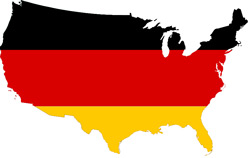I ran across an article posted at the New York Times website titled Whatever Happened to German America? Having German-American ancestry myself, I was drawn to the article, which laid out a case for why the ethnic German communities in America have all but disappeared. Much of the blame was laid on WWI. I concur with the writer’s assessment.
Let me give one quick example.
In 1975, Patty and I bought 50 acres, complete with an old farmhouse, from Alfred and Edward Keating just outside Orting, Washington. In researching the Keating family, we found that family surname was actually Kötting, and had been Americanized to Koeting before 1900. By the time America entered WWI, the Koeting name was no longer being used, and the name was now Keating. As anti-German sentiments rose, Fred Kötting – Keoting – Keating found it much easier to adapt the name, than to use an obviously German surname. World War I changed the once proud German-American community forever. World War II changed it even more. Following is a teaser from the New York Times article.
Berlin — WHAT is America’s largest national ethnic group? If you said English, Italian or Mexican, you’re wrong. Today some 46 million Americans can claim German ancestry. The difference is, very few of them do.
Indeed, aside from Oktoberfest, German culture has largely disappeared from the American landscape. What happened?
At the turn of the last century, Germans were the predominant ethnic group in the United States — some eight million people, out of a population of 76 million. New York City had one of the world’s largest German-speaking populations, trailing only Berlin and Vienna, with about a quarter of its 3.4 million people conversing auf Deutsch. Entire communities, spreading from northern Wisconsin to rural Texas, consisted almost exclusively of German immigrants and their children.
